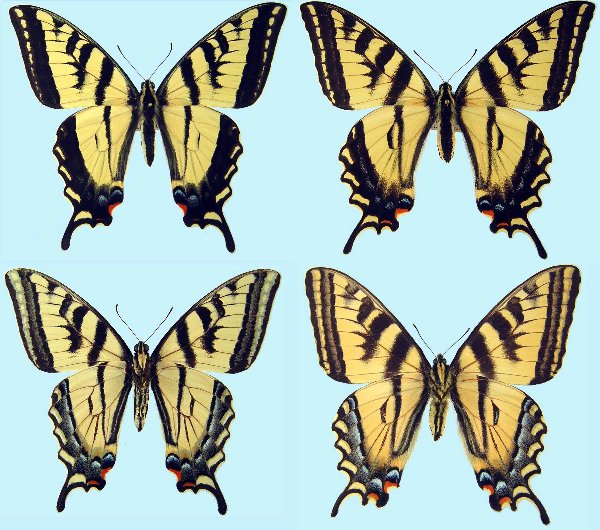Papilio rutulus rutulus

Photo Life History: Papilio rutulus rutulus
Habitat: Mountain Canyons; Valley Lakes & Rivers; Urban-Suburban;
Host Plants: Salix amygdaloides; Salix exigua; Salix fragilis; Salix lasiolepis; Salix lasiandra; Populus angustifolia; Populus tremuloides; Fraxinus pennsylvanica.
Suitable Lab Host Plants: Any willows, cottonwoods, or aspens.
Caring for Live Female Butterflies: Feed females every day.
Methods of Female Oviposition: It's important to set up females in a cage (with nectar sources) where there is plenty of room to fly to and from the host plant. (See this video.) Females set up in a 2' x 2' x 3' cage usually need three to four days of prep in a dark closet where they should be fed daily before being ready to lay eggs. However, females released into larger flight houses (10' x 10' x 7') or larger are usually more cooperative much sooner and seem to lay eggs more quickly in larger spaces.
How to Find Eggs: Because the larval host plants of western tiger swallowtails can be plentiful and tall, it is always wise to look for immatures on isolated host plants, if at all possible. This is not an easy task in Utah and Colorado because of how common host plants are. Population numbers of this butterfly can fluctuate due to predation, parasitism, and other factors.
How to Hatch Eggs: Consolidate eggs into one container.
How to Find Caterpillars in the Field: For earlier instars, look on the dorsal side of the leaf. For later instars, look for swallowtail pads. Finding glaucus-group caterpillars in numbers can be difficult and sometimes requires a certain degree of patience and hard work. Finding eggs and caterpillars seems to be much easier in Idaho and certain parts of Oregon as compared to Utah because host plants are not quite as concentrated. Always remember to look for isolated host plants. This can be especially helpful at places such as Bogus Basin Highway, Ada County, Idaho, where small clumps of willows and poplars grow along the road--the smaller the clumps, the more concentrated caterpillars can be found. This also holds true for Limenitis lorquini burrisoni caterpillars.
Caterpillar setups: Open terrariums; Open Bucket.
Larva to Pupa: Larva purges and wanders; Larva Changes Color.
Number of Broods per Year: 1-3; depending upon location
Overwintering Stage: Pupa.
Overwintering Strategies: Your Own Backyard; Refrigerator
Post-Hibernation Strategies: Expose pupae to room temperature, long-day photoperiod and high humidity (mist spray them daily.)
Avoiding Diapause Techniques: Not applicable.
Disease Prevention: Change out host plant and remove frass every five to six days using the open terrarium technique.
Emergence: Emergence Container
Field Notes:


